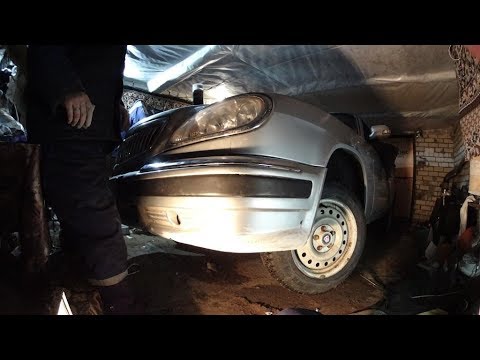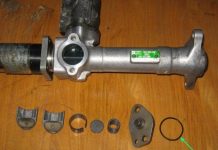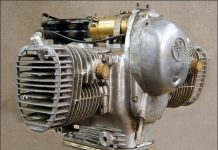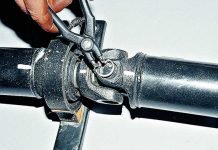In detail: do-it-yourself gas 31105 bumper repair from a real master for the site my.housecope.com.
Cherry Volga returned from a Sunday trip to the city of Tomsk without a rear bumper, the story of its loss deserves a separate story, in which at least three questions must be raised:
The first question is about driving ethics.
The second question - is it necessary to go at all?
The third question - and if you need to go at night.
But today we are not talking about that, today we will talk about how you can reanimate a cracked plastic bumper. As you can see from the title - this is the first part - today we will talk about soldering. What we need:
- Ordinary flat-tip soldering iron. Soldering irons with a point tip, for example, for desoldering chip resistors, are not suitable, the same can be said about very powerful air soldering irons.
- Medium mesh soldering mesh.
- Tweezers, possibly pliers, and a fairly thick sewing needle may also come in handy.
- Wire may be needed.
- Make sure your wife has a hair dryer.
In the last three points, we said “maybe”, the fact is that with some damage it will be easier to first “sew” the bumper in several places with a simple wire, puncture two holes with a hot needle, and then either remove the wire, after fixing the parts with a mesh, or drown wire into the bumper body, heating it with a soldering iron. Pliers may be needed in case two pieces need to be pulled together with wire. A hair dryer will come in handy if the bumper is deformed, and when its parts are joined, stresses arise that will interfere with soldering and eventually destroy the connection, an ordinary household hair dryer will perfectly heat the plastic of the bumper to a state suitable for giving the part of the desired shape.
| Video (click to play). |
First of all, you need to figure out what type of plastic the bumper is made of. On the inside of the bumper there is a marking indicating the type of plastic: PP, PE, TPO - these are soft plastics, they can be soldered with a mesh, you can also glue the crack with specialized glue for such work.
PAG, GF, ABS - these are hard plastics, it makes no sense to solder them. In this case, it is necessary to glue the joint from the inside with fiberglass, using epoxy resin as an adhesive. In this case, it is necessary to clean the surface from dirt with sandpaper. Apply the resin with a brush and stick the fiberglass onto it, then saturate the fiberglass with the resin.
Our bumper is solderable. We used a mesh and a simple soldering iron. Then we glue the resulting seams with fiberglass.
First of all, the bumper parts need to be well washed from dirt; ordinary washing powder is perfect for this purpose.
- We cut the mesh for soldering, so that it covers the crack by 5-7 millimeters, it should also be mentioned that instead of a special mesh for soldering sold in car dealerships, you can use a mesh from the air filter of an injection engine, and similar mesh is sold in construction markets and they cost an order of magnitude cheaper than analogs from car dealerships. But the special mesh has one advantage - it is softer and easier to shape.
- We combine the elements of the bumper, if you need to warm it with a hairdryer, if there is no assistant, then you can fasten the parts with a furniture stapler or wire, after making a hole for the wire with a hot needle.
- We start to solder. The mesh should be soldered, starting from the edges, in increments of mesh division, after a few seconds the mesh will heat up and sink into the plastic without strong pressure, the mesh should be recessed by about half the thickness of the bumper. The following photos clearly show the soldering process.
- The soldering point should be leveled with a soldering iron, so that the traces of soldering are less noticeable.
- If you fastened the bumper elements with wire, then it should either be removed or sunk into the surface of the bumper with a soldering iron. The resulting influx of plastic around the staple should not bother you, they need to be sanded, and then the putty will do its job.
- After soldering from the inside, the bumper must be soldered with a fine mesh outside. At this stage of the work, you need to be more careful. We repeat step 3, and then we do step 4 more thoroughly.
- After soldering, we process the resulting seam with a sandpaper of grain size p180 - p240.
- Then you need to start filling. But more on that in the next part of the article.
I had a couple of relatively free days. There was not enough money for major repairs of the available equipment, and small for that and small, which is always postponed until the last moment. : sm38: And so, thinking about what to do, I left the entrance and. stumbled upon the remains of the rear bumper of his beloved “Volga”. There are no photos, because it was a shame to take them. But in words I can explain that in both corners there was no bumper at all, and a very solid shred was snatched out in the center. There were cracks all over the bumper. The amplifier and chrome trims have been deformed in many places. In general, when I told the peasants that I would restore it, they laughed so hard that the gate almost flew out in the garage. But when I recalled that the new one costs 6,500 rubles, interest arose in the views. And I got down to business!
The technology for restoring a completely dead bumper looked like this:
1. I remove and disassemble the bumper (It took 10 minutes to remove, but I had to tinker with disassembly. Everything was badly deformed and it was very difficult to separate the parts from each other.)
2. I threw the pads aside, the elastic band too. First of all, I took up the simplest work - with the help of a large hammer and a sledge hammer, I adjusted the amplifier.
3. Then he took the pieces of the remaining plastic, estimated the places where they could be on the normal bumper, laid it out on the workbench and tried to imagine the sizes of the necessary "patches".
4. Drove to the store. I bought 100 pieces of self-tapping screws 4 * 16, and from the trash heap I dug ten cans from under the car putty.
5. I cut tin from cans and formed the missing "patches" from it.
6. From the inside of the bumper, screwed the sheets of tin with self-tapping screws and hung the resulting structure back on the amplifier.
7. Grinder sawed off the ends of the screws sticking out from the outside.
8. I bought 2 kg of putty with fiberglass and within 3 days brought out the desired shape.
9. Now it's the turn to overlays. First, I tried to return them to their correct shape with an ordinary hammer. With a hammer, because there was nothing to save - pearl rust from everywhere.
10. Then he fitted and secured the pads back to the bumper, rubbed them with the 280th sandpaper and. About a miracle! The rust almost disappeared without taking the chrome with it.
11. I put aside the prepared spray with paint "under chrome" and decided to leave the lining as it is.
12. Put in place the rubber band and, for faithfulness (in the absence of glue), took it on the screws from the outside. Better, by the way, to do it from the inside.
13. Installed the bumper on the car (the putty tolerated deformation well during installation and did not even crack).
14. I put in a few more layers of putty.
15. Primed from a spray bottle.
16. Painted with black enamel also from a spray bottle.
Result: The right corner is almost perfect. The middle is pretty good too. The left one was a bit lacking in patience and the fact of repair is noticeable there if you look closely. But I will finish it later, when I paint the car.
In this article we will talk about the car - Gaz-3110 "Volga", or rather about how you can independently repair its front bumper. Volga is a Russian middle class car. This car was produced by the Gorky Automobile Plant from 1997 to 2004.
In 1997, a limited transition version was produced, which was equipped with interior door skins from previous models. From the very beginning, a narrow bumper made of black thermoplastic was installed on the 3110 gas, and in 2000 it was replaced with a voluminous overhead plastic bumper. Thus, the manufacturers completely renewed the car's interior, and its trim began to meet the standards of not very expensive foreign cars. Naturally, each time the manufacturers came up with new updates to the gas 3110 car and in 2004 they stopped producing gas 3110 and started producing gas 31105. Gas 310223 is the last model of the Volga family, it was produced by conveyor assembly, and its last batch was released in 2008.
The generally accepted disadvantages of the first models of gas 3110 are considered to be not very good build quality and low body resistance to corrosion.
In the course of numerous improvements, the shortcomings of the 3110 gas were partially removed, but due to the general moral obsolescence of the design of this car model, as well as passive and active safety, the demand for 3110 gas has significantly decreased. Despite all this, the Volga is considered quite hardy and inexpensive, which is why it became a common model in Russia. Gas 3110 was exported to many countries, including pre-war Iraq.
Each of us may have some kind of trouble with the car, such as a dent, bump or scratch. But do not be upset, because how they can be restored, while saving your money. If you have a similar situation, then first of all you need to collect all the fragments of the plastic body kit, and then listen to the advice of this article.
The question immediately arises: What is the best way to start repairing the front bumper of the gas 3110 model? First you need to remove it correctly. Consider the algorithm for removing the bumper gas 3110:
- Disconnect all connectors for the fog lights, on the headlights or in the engine compartment;
- Using a 12-point head, unscrew the two bolts on the side bumper mount. They are located under the front wing;
- Using a 17 key, unscrew the two bolts on the front bumper mount. They are also located under the front wing;
- Pull the bumper slightly towards you and remove it;
- If you need to replace the bumper bracket, then you need to unscrew with a 12-head 4 bolts securing them;
- Remove the bracket.
After the front bumper has been removed, you need to determine the model of the car and the chemical formula of the structure of the bumper itself. You need to know the make of the car in order to decide on the method of repairing the bumper. You can find out the chemical formula of the bumper on its rear side.
In order not to delve into the details of the chemical analysis, you must divide the bumpers for yourself into the following:
- Good. During their repair, no problems arise, and they are easy to repair;
- Rubber, nylon or rubberized. They have propylene in their composition, and this does not make it possible to weld the front bumper.
If you are going to repair the front bumper by welding, then you will need:
- Dark and light room;
- Workbench;
- Soldering iron from 40 to 60 watts;
- Hair dryer;
- Knife;
- Small sharpener for preparing electrodes;
- Small metal scissors for cutting electrodes;
- Flat screwdriver.
Diagram of the front and rear bumpers of GAZ 3110
If you are going to repair the front bumper using the gluing method, then you will need:
- Dark and light room;
- Workbench;
- Awl;
- Synthetic thread up to 1 mm;
- Fiberglass or charcoal;
- Rivet gun;
- Rivets;
- Glue. It is not recommended to use bazaar adhesives. Buy exclusively fresh glue from the factory in the amount necessary for repairs, and if not enough, then it is better to buy it later.
We repair the front bumper of the gas model 3110 by welding:
Place the front bumper on a workbench and estimate the amount of work to be done.First you need to choose the right electrode. Most people believe that if the bumper can be cooked, then immediately you can get down to business, no matter what exactly it is to do it. But this opinion is erroneous, since the quality and reliability of the welded seams depends on the correct choice of the electrode. Due to such a rather common mistake, the welded front bumper of the 3110 gas model can simply break during preparation for painting it. If you choose the wrong electrode, it will simply smear over the bumper. There are often cases when the front bumper is not cooked at all.
From the very beginning, you need to try whether the front bumper is brewed on itself. To do this, cut off a small part from the inside of the bumper and try to weld it to the bumper. In any case, you should try to use only homogeneous materials. To do this, cut a piece for the electrode from exactly the same bumper. Sometimes it is very difficult to select the necessary electrodes and then you will need to experiment.
After you have chosen a suitable electrode, you need to carefully clean the joint to be repaired from paint and accumulated dirt. Next, you need to heat the soldering iron and pulling the two particles together, draw them along the joint with a soldering iron so that they grab each other and form a groove along the length of the seam to be repaired. Sharpen the cut electrode on the sharpener so that it has a triangular cross-section. During welding, the edge of the electrode will sink in the trench already made with the soldering iron. The welding area will also increase, which means that the quality of the seams will increase. To facilitate the initial process, it is better to sharpen the tip of the electrode to the thickness of the needle. Next, turn on the hair dryer with operating temperature and attach the sharp end of the electrode to the beginning of the seam and start welding, and at the end you need to rotate the electrode. In the case of torn pieces from 3 to 6 mm, it is better to use a flat electrode.
After you have finished welding, you need to clean the seam on the side of which the welding took place. If a bump forms, you need to warm it up with a hair dryer on the inside. The same action can be applied in the event of a defect in the bumper without damaging the paint, repairing headlights, grilles, etc.
We repair the front bumper of the gas model 3110 by gluing:
From the inside, use a hair dryer to warm up and level the surface. Next, we clean the adjacent sides for a better fit. After that, you need to make small holes for the thread at a distance of 3 - 5 mm from the seam on both sides. Make grooves between the holes and diagonally to the next. Tie the thread in the first holes into a knot and sew a seam. You need to sew a seam with one end of the thread, and the other end lies along it. It all lies in the fact that one end of the thread tightly pulls the seam, and the other adheres to the bumper. Finally, tie a knot and your seam will be placed on the inside.
We degrease the surface with a solvent, and then stir the glue with a hardener. Cut the fiberglass into small klaptiki and mix with glue. Apply the resulting mixture to the seam. Leave the bumper to dry for 15 hours and clean the outside of the bumper. It is best to paint the bumper before using the bumper.
Nizhny Novgorod Volgovodov Club
a torch melts much better than a soldering iron. Some years ago, I also collected a broken bumper, so I made myself such a burner. The entire design of the burner came out at 500 rubles (for those who are interested in how to make it, I can tell you on ICQ 441604594 or in a personal)
if I was bothered to repair the bumper, I would use exclusively epoxy and construction bandage or fiberglass.
And I would “wrap” in the impregnated material not only the place of the crack, but the entire bumper from all sides, so that a closed molded skin would form.
When it is dry, I would apply with spatulas layer by layer (2-3 layers), carefully sanding each layer with a final sanding with zero.
After such work, nothing would ever peel off. At least it wouldn't have fallen off.
P.S. I have the right to give advice and be clever, because at -20 I changed the radiator with partial dismantling of the gas main
Removing and installing front bumper
It is more convenient to remove the front bumper when the car is raised on a lift or installed over a viewing ditch.
To replace the front bumper of the Volga 31105 car, you will need:
1. Unscrew the side bumper mounting bolts on both sides.
2. Remove the two front bumper mounting nuts.
3. Remove the bumper by pulling it forward.
4. Install the front bumper in the reverse order of removal. When installing the bumper, put rubber pads on the side mounting bolts.
Removal and installation of the back buffer
To replace the rear bumper of the Volga 31105 car, you will need:
keys "12", "17", screwdriver.
1. Fold over the edge of the boot mat to allow access to the boot trim attachments.
2. Pry with a screwdriver and remove the clips for securing the rear luggage compartment trim. Remove the rear trunk lining.
3. Remove one bolt of the side bumper fastening on both sides.
4. Unscrew one nut at the rear bumper mounting on both sides of the vehicle.
5. Remove the buffers by pulling it towards you.
6. If it is necessary to remove the splash guard, remove three bolts on each side of the vehicle and six bolts on the bottom.
7. Install the rear bumper in the reverse order of removal. When installing the bumper, put rubber pads on the side mounting bolts.
We pry on with a screwdriver and take out 8 plastic caps of the lining.
Remove the plastic rear panel overlay.
Using the “12” key, unscrew the two bolts of the side bumper attachment to the rear fenders.
Using the “17” key, unscrew the two nuts securing the bumper to the rear panel.
Remove the bumper by pulling it towards you.
Install the bumper in reverse order.
If there are no rubber washers on the side brackets of the bumper, then, before installation, in order not to damage the body paint, put a rag on both ends of the bumper.
1. Roll up the edge of the luggage compartment mat to provide access to the luggage compartment trim attachment parts.
2. Hook up with a screwdriver and pull out the clips securing the rear luggage compartment trim. There are 8 of them
3. Remove the rear plastic luggage compartment trim.
4. With a 12 key, unscrew the two bolts of the side bumper attachment to the rear fenders.
5. Unscrew one nut each with a 17-inch wrench on the rear bumper mounting on both sides of the vehicle.
6. Remove the bumper by pulling it towards you
7. If it is necessary to remove the mudguard, remove three bolts on each side of the vehicle, as well as six bolts at the bottom.
Install the bumper in reverse order. Before installation, in order not to damage the body paint, we put a rag on both ends of the bumper.
The station wagon bumper consists of three parts: a central part and two side parts.
1. Remove the two license plate lights from the bumper.
2. With a 17 key, unscrew the four nuts from the bottom of the car
3. Remove the limiters for opening the cover of the spare wheel well.
4. With a 17 key, unscrew the four nuts
5. Remove the central part of the rear bumper
6. With a 17 key, unscrew the nut from the bottom
7. With a 12 key, unscrew the bolt in the side cavity of the spare wheel niche
8. Remove the side bumper. Remove the second side part of the bumper in the same way.
Install the bumper in reverse order.
The GAZ-31105 model is considered the crown of the development of the Volga, which gained fame as a business-class car back in the days of the USSR. In fact, this is the last original model of the plant. Despite the originality and high-quality design, many motorists want to highlight their car, and this can be done thanks to high-quality tuning.With its help, weaknesses are hidden and strengths are emphasized.
Tuned Volga GAZ 31105
A distinctive feature of the car has always been the volume of the cabin. Several people could comfortably accommodate here, while all the conditions for long journeys were created. Nevertheless, the car was inferior to its foreign counterparts of the same class in terms of comfort.
Tuning option for the interior of the Volga GAZ 31105
- replacement of seats;
- improved noise insulation;
- change of decoration;
- diode inserts;
- replacement of handles;
- replacement of the instrument panel.
Even partial tuning in such cases leads to significant positive results, but a sense of proportion and taste must be present.











